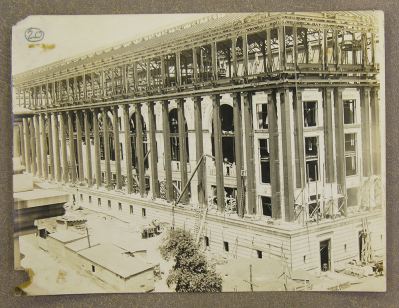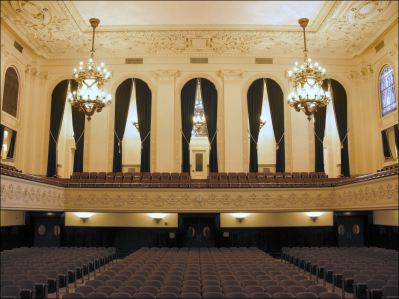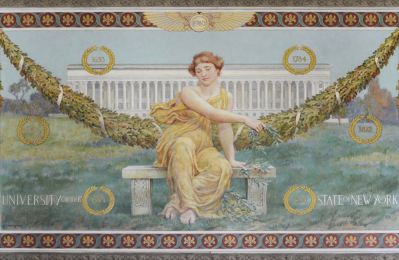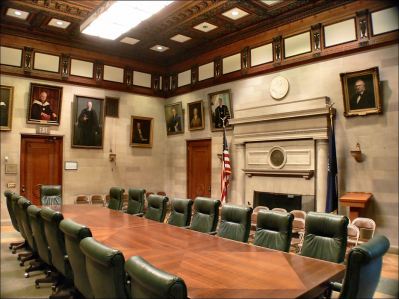Information and History of the State Education Building
Location
The State Education Building is located at:
89 Washington Avenue
Albany, NY 12234
Inception
Construction of the New York State Education Building began in 1908 by the firm R.T. Ford and Company of Rochester, NY. The building costs at the time amounted to nearly $4 million and covered everything from the purchase of the land to construction of the building. The building was dedicated in 1912.
Design
The Education Building was designed by renowned architect and New York City native Henry Hornbostel. The Education Building was the first major building constructed in the United States solely as a headquarters for the administration of education. As such, the design Hornbostel used closely resembled that of the Columbian Exposition in 1893, “where higher ideals and serious scholarship were believed to be best expressed in the classical idiom.”[1]
The front façade features a 36-column colonnade which remains one of the longest in the world and was designed in an effort to distinguish the Education Building from other New York State government buildings already existing on Capitol Hill. The columns are 90 feet in height and made of Vermont marble. On the front stairs of the building, there are two large, educationally themed sculptures designed and created by Charles Keck from New York City. Keck is known for many of his historical sculptures throughout the United States.
Remarkable Features
Chancellors Hall
Originally called “The Auditorium,” Chancellors Hall has its ground floor in the basement of the Education Building and spans two stories “with a gallery and promenade on three sides.”[2] On the stage are two columns (one to either side of the stage) and four elaborate Beaux arts gold chandeliers adorn the ceiling. Natural light floods in from a series of stained-glass windows on the east and south facing sides of the building. The windows continue around to the north side, however they look into a corridor. Chancellors Hall seats approximately 800.
The Rotunda
From the main entrance on Washington Avenue, immediately to one’s right is a wide marble staircase leading to the second floor and a breath-taking Rotunda extending all the way to the roof of the Building. Three large barrel vaults and a central domed glass skylight allow the Rotunda to fill with daylight. The Rotunda is “built on a cruciform plan with a ninety-four foot high dome located at the crossing.”[1] The room also contains large murals designed to depict the quest for Enlightenment. The murals were created by Albany, NY native Will H. Low who studied art at the same institution where Hornbostel studied his craft. The Rotunda is adorned with more columns, adding to Hornbostel’s overall classical design. The chandelier that currently hangs in the center of the Rotunda is 75 feet in length and is plated in aluminum leaf.
The Rotunda Paintings
The New York State Education building, constructed in a grand Neoclassical style between 1908 and 1912, was designed to “impress the popular mind with the important place which education holds in the thought and policies of the Empire State.” Similarly, the thirty-six paintings, created by Albany artist Will Hicok Low, possess a timeless quality of beauty and grace and serve as an architectural accompaniment to the building. Additional information available from the New York State Museum's website: The Rotunda Paintings.
The Reading Room
The Reading Room is made of 12 steel columns and Guastavino vaults which reach up nearly 50 feet high and help to “support a network of domes composed of light and dark tiles.”[1] Previously, The Reading Room had numerous chandeliers dropping from the center of these individual “domes.” The Reading Room also served as the access point via mechanical elevators to “the Stacks”, where a maximum capacity of 2 million volumes of books were originally housed in the New York State Library.
The Stacks
Designed originally to house the collection of the New York State Library, the original structure of the Stacks remains intact today and serves as housing for volumes of files of the Education Department since the Library has moved to the Cultural Education Center. However, the Stacks are still a unique space as the low ceilings, limited lighting, original elevators and marble walkways between narrow rows of shelves make the Stacks like few other interior locations in the world. At the time of the Building’s dedication, the Stacks were heralded as “artificially lighted” and “the temperature, humidity and ventilation of which can be absolutely controlled.”[2]
The Regents Chamber
The meeting room for the Board of Regents is the same today as it was when the building was first dedicated. Located in the southwestern corner of the first floor, the room is constructed of Indiana Limestone with an oak coffered wood ceiling. The Board of Regents conducts its monthly meetings in this room.
The Commissioners Quarters
Directly adjacent to the Regents Chambers is the Office of the Commissioner of Education and the President of the University of the State of New York. The office is decorated “in the Tudor style of Gothic with mahogany wainscoting.”[2]
Other Features
While most of the building currently serves as office space to conduct the daily business of the Education Department, it is important to look back to what was once housed within the building. The State Education Building previously accommodated the New York State Library and the New York State Museum as well as the offices for the Education Department’s staff.
The third floor originally housed the Examinations Division, the Educational Extension Division, the Public Records Division, the History Division and the Library School as well as the conference rooms for Boards of Examiners. Currently, the third floor is comprised of office space and is occupied by the office of Special Education.
The fourth floor currently houses the Office of Fiscal Management of the Education Department. However, when the building opened in 1912, the fourth floor was dedicated to house many of the collections of the New York State Museum including collections in geology, mineralogy, paleontology, entomology, archeology, botany and zoology. Before it was divided into its current form of multiple inner offices, the area was “570 feet in length, 50 feet in height and 54 feet in width; it [was] not equaled in open and dignified space by any other museum in the country.”[2]
The fifth floor was originally exhibit space for the New York State Museum and is currently occupied by Human Resources, additional Fiscal staff and the Office of Higher Education.
When completed, the Education Building was a marvel of modern safety:
Not only is the building fireproof in every detail, but special provision has been made for the safekeeping of manuscripts and other valuable relics which are in the possession of the Department. A large safety vault, 15 by 43 feet, with ample steel boxes and cases, has been built in the basement. Within this there is a smaller vault of special construction which will be used for the safekeeping of the Emancipation Proclamation, Washington’s Farewell Address, the Andre papers, the King Charles II Charter, the Washington relics and other unique papers and relics… The thoroughness with which the construction of the building insures every modern facility for administration and assures every protection against fire.[2]
The Education Building was originally designed to exemplify the progress of education in the State of New York. The Building has undergone many changes throughout the past hundred years and the world of education has transformed as well. Nevertheless, the Building still stands as a beacon of educational advancement and progress.
Bibliography
- "National Registry of Historic Places Inventory – Nomination Form." The New York State Office of Parks, Recreation and Historic Places.
- Cheney, Lloyd L. (editor). Souvenir of the Dedication of the New York State Education Building. Albany, NY: New York State Education Department, October 1912.









